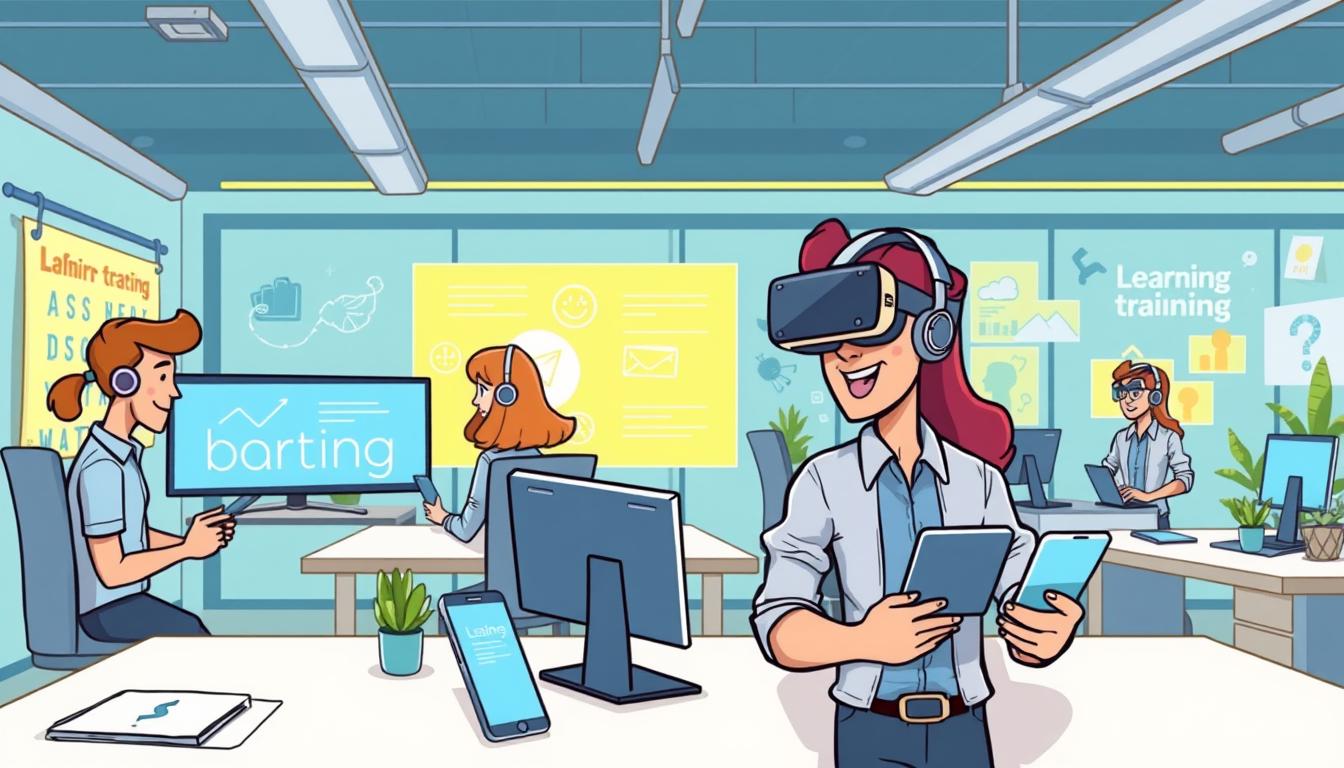What is Microlearning? The Future of Employee Training Explained
Could a short lesson change how your teams learn and remember things?
Microlearning gives short, focused lessons, often just two to five minutes. These lessons match Ebbinghaus’s forgetting curve. ATD says sessions under 13 minutes prevent information overload. This leads to a 17% increase in knowledge sharing.
This method lets employees learn at their own speed without feeling stressed. Studies show that short learning sessions boost engagement. Microlearning is showing the way to digital training with lasting effects.
Key Takeaways
- Microlearning segments are most effective when kept under 13 minutes.
- Two to five-minute lessons help employees absorb and recall content.
- Organizations report a 17% increase in knowledge transfer with microlearning.
- This approach eases cognitive load and aligns with the forgetting curve.
- Short, targeted training fits fast-paced corporate environments.
Understanding Microlearning: Core Concepts
Short training sessions can bring new energy to learning. Lessons under ten minutes help avoid feeling overwhelmed. They keep people eager to learn more.
Studies show that breaking content into small parts helps remember information better. It also makes applying new ideas at work faster.
Definition of Microlearning
Microlearning gives knowledge in focused segments. Each module covers one topic at a time. This way, employees can learn skills without interrupting their day.
This method tackles common time issues. It provides workers with practical tools they can use immediately.
Key Characteristics
- Modules often span one to ten minutes
- Focused lessons tailored to specific objectives
- Formats might include short videos or quizzes
- Repeated exposure to reinforce understanding
Importance in Modern Training
Many employers say they skip training due to lack of time. This shows the benefits of microlearning. It improves retention and keeps employees engaged.
This approach works well with different devices. It makes learning easy at any time.
| Aspect | Key Point |
|---|---|
| Engagement | Short sessions maintain high interest levels |
| Accessibility | Mobile-friendly for workers on the go |
| Retention | Content is memorable through repeated practice |
The Rise of Microlearning in Employee Training
Microlearning is becoming more popular as short, focused lessons replace long lectures. People find these brief modules more engaging. This change fits well with today’s training methods. Studies show a big interest in this approach worldwide.
Companies are now using short, media-rich modules instead of long sessions. Experts say this helps people remember more because it fits their short attention span. This method meets the demand for quick, on-demand learning, like what social media offers.
Historical Context
Training used to be about all-day classes or thick manuals. Tech giants like Google started using online tools to break down complex topics into easy-to-digest pieces. This change lets employees learn at their own pace, fitting new training methods.
Current Trends in Education
Today, people easily adapt to digital learning. Busy lives and remote work mean trainers need to offer flexible, mobile-friendly lessons. Microlearning meets this need by providing frequent, brief lessons that reinforce learning without being too much.
| Aspect | Microlearning Advantage |
|---|---|
| Session Length | Short and easy to complete |
| Engagement Level | Increased focus on key topics |
| Accessibility | Immediate access from any device |
Benefits of Microlearning for Organizations
Short training segments make work easier for employees, boosting their motivation. This method changes how we learn, allowing teams to learn at their own speed.
Microlearning lessons are brief, lasting from three to ten minutes. They offer quick, focused knowledge without needing to leave work for hours. Here are the main benefits that boost productivity and help organizations succeed:
Enhanced Engagement Levels
Engaging lessons spark curiosity, making employees eager to participate. Short tasks are manageable, leading to more frequent and successful completion.
Improved Retention and Recall
Revisiting brief lessons helps workers remember better. Regular practice solidifies new ideas, a key strategy for the future of learning.
Cost-Effectiveness
Creating shorter modules is cheaper, saving time and money. Companies often avoid expensive programs, making microlearning a budget-friendly option.
How Microlearning Fits into the Learning Management System (LMS)
Organizations are using microlearning to boost their training. Short modules, lasting 2–10 minutes, fit well into current systems. This makes learning flexible and easy for employees.
Integration with Existing Systems
Platforms like Cornerstone OnDemand and Moodle make it easy to add short videos or quizzes. Managers can pick content for each team, making learning relevant. This way, employees get reminders to keep learning.
Leveraging Analytics for Improvement
Tracking how learners do helps leaders see what needs work. This info helps update old lessons. A study by Software Advice shows a big jump in employee interest with this method.
Various Formats of Microlearning Content
Short bursts of knowledge help employees stay focused, even when they’re busy. Studies show microlearning can improve learning by 17%. It’s great for filling skill gaps in fast-paced industries.
Video Modules
Short videos offer clear instructions and guides. Most are under 15 minutes, perfect for today’s short attention spans. They’re great for digital training when you need to see something.
Interactive Quizzes
Quizzes make learning fun and track progress. They help remember new information and show where extra help is needed. They keep team members engaged.
Infographics and Short Readings
Infographics make complex data easy to understand. Short articles give key information quickly. These tools help reinforce learning on demand.
Best Practices for Implementing Microlearning
Companies that use bite-sized training see big benefits. Short sessions, lasting from two to ten minutes, keep learners focused. For example, Keurig Dr Pepper uses quick videos to make onboarding fun and teach important lessons.
Designing Short, Engaging Lessons
Lessons need to grab attention. Adding interactive parts or real-life examples helps. Studies show that clear images and short texts help learners remember more.
Using animations or infographics can make key points stand out. This way, learners don’t get overwhelmed.
Adapting Content for Diverse Learner Needs
Today’s workplaces have people who learn in different ways. Some like video tutorials, while others prefer quizzes or infographics. Offering various learning styles helps everyone grow, like at IBM or Coca-Cola.
Continuous Feedback and Revision
Checking quiz scores and how much learners complete helps improve training. Merck’s success in reducing accidents shows the value of using data. When learners struggle, updating content can help them get back on track.
Challenges of Microlearning in Practical Settings
Teams might be slow to accept short training modules. They often prefer longer training sessions. This can make them doubt the value of microlearning.
In places where managers stick to old ways, new learning methods can face challenges. This can slow down efforts to improve corporate learning.
Resistance to Change
Some people think short training is not enough. They expect longer sessions. Changing this view is key.
Explaining how microlearning helps solve skills gaps can help. It shows its value and eases fears.
Ensuring Quality of Content
When many experts work together, content can get mixed up. Good editing keeps things clear and focused. This builds trust in the learning process.
A well-planned approach to each lesson is crucial. It ensures the material is clear and useful.
| Common Obstacles | Potential Solutions |
|---|---|
| Employee Skepticism | Demonstrate evidence of higher retention rates |
| Fragmented Modules | Implement consistent quality checks |
| Limited Buy-In from Leaders | Define strategic value and offer pilot programs |
Case Studies: Successful Microlearning Implementations
Short learning bursts can really spark enthusiasm and lead to better results. When companies use bite-sized lessons, retention rates often hit 80%. This is because these lessons fit into busy schedules perfectly.
Examples in Technology Companies
Google’s Primer app shows how big tech delivers easy, interactive lessons. These cover topics like branding and digital marketing. Small businesses get quick skill-building modules that match market changes.
This approach makes them agile. It focuses on topics that users can learn in minutes.
Microlearning in Healthcare
Merck has started short safety training sessions that boost participation and cut down incidents. Medical teams face constant changes in patient care and treatments. So, concise updates are key.
In fast-paced clinical settings, these focused modules keep caregivers up-to-date. They learn about new therapies without feeling overwhelmed. This method has increased staff engagement, as they prefer quick, relevant information.
The Role of Mobile Learning in Microlearning
Short training segments on mobile devices make learning easier. Many find it convenient to learn during breaks with their smartphones. This change allows for flexible training, helping workers learn in short periods.
Accessibility and Flexibility
Employees can learn while commuting or waiting in line. A poll found 28% of unhappy workers prefer shorter training sessions. This matches microlearning perfectly. Constant access to training boosts engagement and retention.
Tools and Apps for Delivery
Intuitive apps and LMS platforms make updates and sharing easy. These digital spaces allow teams to get new content quickly. Short quizzes or flashcards help keep focus on one topic.
| Key Data | Details |
|---|---|
| Employee Preference | 28% favor shorter training sessions |
| Attention Span | Down to 8 seconds, per Microsoft study |
| Predicted Trend | Mobile learning set to dominate by 2025 |
The Future of Microlearning: Predictions and Trends
Experts say microlearning will keep growing as companies want flexibility and cost savings. New platforms are making learning easier to fit into any system. By 2019, it was clear that microlearning was engaging employees more than ever before.
In 2020, its use jumped by 40%. Short lessons are now better at keeping people interested in learning new skills.
AI and Personalization
Artificial intelligence is making learning more personal. It tracks how well you’re doing and suggests lessons based on your level. This makes learning more fun and helps you reach your goals faster.
The Ongoing Evolution of Learning Styles
Learning in small chunks is still popular because it fits our short attention spans. By 2025, learning on mobile devices will be even more common. This makes it easy to learn on the go and apply what you learn right away.
Expected Industry Changes
Big names like Google are looking into using virtual and augmented reality for learning. These technologies let you practice in a simulated environment, saving time and money. They promise to make learning more interactive and engaging for everyone.
Source Links
- What is Microlearning
- The Future of Microlearning
- What is Microlearning? – Benefits, Challenges & Best Practices
- The Rise of Microlearning: Impactful Employee Training Sessions
- What is Microlearning? Examples and Best Practices [2024]
- What is Microlearning, and Why is it Being Hailed as the Future of Employee Training?
- The Rise Of Microlearning: Transforming The Way People Learn
- Microlearning for Effective Employee Training
- A review of the trend of microlearning
- What are the benefits of microlearning in the workplace?
- The Future of Learning: Microlearning and Its Benefits
- Microlearning: The Complete Guide to Strategy, Examples & More
- What Is Microlearning? The 7 Major Business Benefits | Vouch
- Microlearning In The Workplace: The Future Of Employee Training
- What is microlearning and why you should use it
- Council Post: Microlearning: The Future Of Professional Development
- Introducing Microlearning: Revolutionize Employee Training
- What is Microlearning? Benefits, Examples, & Strategies
- Building Employee Skills With Microlearning
- What is microlearning? In-depth guide for 2024
- Exploring the Impact of Microlearning in LMS on Remote Employee Performance and Retention
- Implementing Microlearning Strategies: A Comprehensive Guide for 2024 – Innovito
- Microlearning in Learning Management Systems: Best Practices & Trends
- What is microlearning and how can it benefit your training?
- Why Micro Learning Is The Future Of Training In The Workplace
- Microlearning: The “OG” or Hot New Trend?
- Microlearning Trends | OttoLearn Microlearning Platform
- Integrating Microlearning into Corporate Training: The Future of Employee Development







